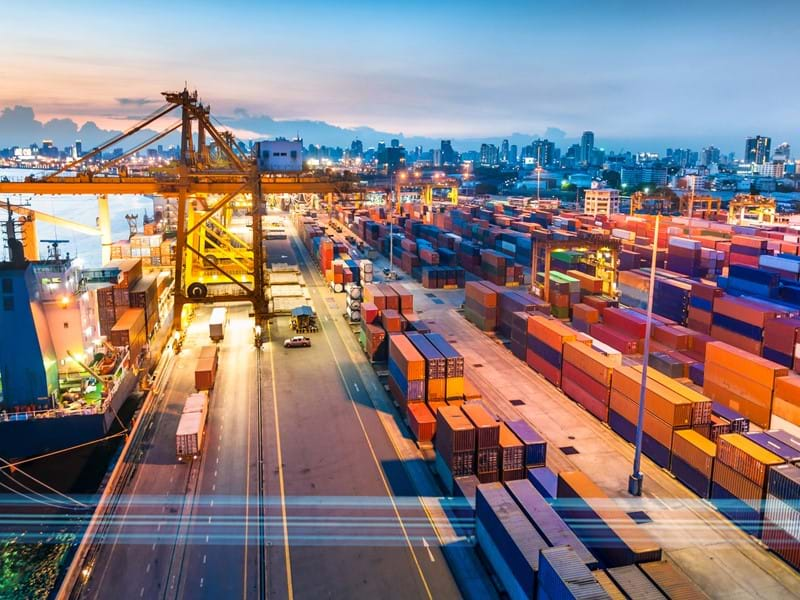Negotiating Ocean Freight Rates for Your Business

Somewhere between 80% and 90% of freight shipped around the world moves via the ocean. That’s a lot of goods! High freight volumes mean that a lot of negotiating shipping rates occurs in this segment of the transportation market. How can shippers master freight negotiation with shipping companies that offer ocean transport? Read on to learn more.
Negotiating Ocean Freight Rates
The keys to negotiating ocean freight rates aren’t really that different from negotiating the terms offered by any other service provider. Successful negotiation starts with educating yourself, which in this case means getting familiar with the types of ocean freight shipping options available, which services you need, and the market rates and common rate structures. This knowledge helps shippers go into negotiations grounded and informed.
Once shippers enter the negotiation phase, they should keep in mind that flexibility is key and, while a great rate is nice, it doesn’t mean anything if a quality service isn’t rendered. By diversifying their carrier base, shippers leave themselves with a little more wiggle room. It’s critical to keep in mind that the best outcome in a negotiation is both parties getting a fair rate.
How to Calculate Ocean Freight Rates
Ocean freight rates are usually calculated depending on mode of transportation. Typically, LCL (less than container load) is calculated based on weight and measurement. FCL (full container load) is calculated per type of equipment. Ocean freight rates are often written as cost per kilogram, which makes sense since most of the world uses the metric system and ocean shipping is a global endeavor.
However, despite this simplistic explanation, calculating ocean freight rates isn’t all that simple. The following factors majorly play into ocean freight rates and can fluctuate rapidly as the market or other economic conditions shift:
- Frequency of shipments
- Freight volume
- Freight class
- Fuel prices
- Regulatory concerns (emissions requirements, etc.)
- The size of packages in the shipment
- The type of contract between the carrier and shipper
- The insurance necessary to cover the expense of replacing cargo in the event of damage
- The size of the container
- Whether the shipment will utilise a full container (FCL - full container load) or will share a container with other cargo (LCL - less than container load)
- Special handling requirements, including:
- RORO (roll-on, roll-off)
- Project cargo
- Out of Gauge
- Reefer
- Flexitank
Common Ocean Freight Terms, Surcharges, and Fees
The terms and costs of an ocean freight shipment are often split into pre-carriage (before the ship), on-carriage (after the ship), and carriage (on the ship) charges. Here are some common fees and surcharges that are included in ocean freight contracts.
- Drayage fees: These account for the movement of goods to or from the ship (i.e., a container being pulled off a rail car near the port and moved to the port itself for loading)
- Fuel surcharges: These charges help account for fuel prices
- Low sulfur surcharges: To cover the additional costs of using low emissions low sulfur fuel
- Bunker adjustment factor (BAF) and emergency bunker surcharge: These are both fuel surcharges that help carriers account for spikes in fuel prices
- Currency adjustment factor: This accounts for currency fluctuations between the US dollar and currency in the country of origin; most common on shipments coming from the Pacific Rim
- Verified gross mass fee: This is essentially a charge levied for weighing the cargo inside of the container
- Heavy lift and Out of Gauge fees: For cargo that is heavy or large enough to not fit in a regular container
- Carrier security fee: Ports charge carriers a fee to offset the costs of maintaining an ISPS secure port, and carriers pass that fee onto shippers.
3 Common Types of Ocean Freight Contracts
- Long-term contracts - Long-term contracts are generally set for one year, sometimes two years. Rates and surcharges are typically fixed during the contract period.
- Short-term contracts - Short-term contracts may cover a fixed-price period of a month or a quarter.
- Index-linked contracts - Index-linked contracts have become more popular in the past couple of years of price volatility. These types of contracts are based on an external index. This means rates are closely in line with market rates at the time of shipment.
4 Tips to Help Shippers Rest Easy in Their Ocean Freight Contracts
- Read the contract thoroughly before signing. Your freight rates should never come as a surprise; it’s in the contract!
- Vet potential carriers carefully. Using a carrier with a solid reputation can go a long way toward making sure the service meets expectations.
- Be sure the carrier understands your needs. With variations in terminology and differences in pricing structure, it’s important to get an accurate idea of what your contract rates will get you and whether the carrier understands your particular needs to ensure the terms align.
- Build relationships with carriers. This can help during negotiations and with communicating, organising and executing shipments.
Will Ocean Freight Rates Go Down in 2023?
In the second half of 2022, we saw ocean freight rates plummet across essentially all shipping lanes as low peak forecasts and an increased level of carrier volume collided. Does that mean it’s likely that ocean freight rates stay down in 2023? The answer is probably so. Industry experts don’t expect to see rates rise substantially or sustainably until the end of 2023, at least.
With the global economy running up against headwinds as inflation finally catches up with us, we can expect to see ocean freight rates stay low through 2023, especially compared to the record-high ocean rates we saw during the pandemic.
Due to the additional steps required in returns processing, it can take longer than an initial order, especially during the surges of returns that are common after major holidays. Smaller businesses without dedicated returns staff may even set returns aside to be processed later.
That may mean it takes additional time to get the end customer a refund or replacement. This can really hurt businesses during the post-holiday season.
What Do Sustained Low Ocean Freight Rates Mean?
Low freight rates are obviously nice for shippers, especially after the soaring rates of the past couple of years, but what do those low rates mean?
With sustained low rate projections, negotiating freight rates won’t be any less tricky, unfortunately. Carriers will be more eager than ever to make sure they’re getting a fair market value for each shipment as low freight rates cut into their profit margins, a shock to the system when they were receiving record-high profits within the past couple of years.
Low rates mean that carriers are less likely to enter into long-term contracts since those contracts would tie down their rates near current market rates. We’ll likely see more carriers opting to use index-linked contracts to prevent losing out on cash during the (likely small and not sustained) rate spikes coming in the next year. Short-term contracts will be the status quo during 2023’s contract negotiation season.
In Over Your Head Negotiating Ocean Freight Rates?
You don’t have to go it alone. A trusted 3PL partner like SEKO can help you keep your ocean freight rates in check and your shipments moving smoothly. Contact our team to see how we can help.
INSIGHT DELIVERED DIRECT TO YOUR INBOX
WANT TO KNOW MORE?
Everything we do is designed to make our clients' lives easier - helping them to develop and maintain excellent relationships with their own customers. Let us know what business challenges you are facing, and we'll see what we can do to help.

